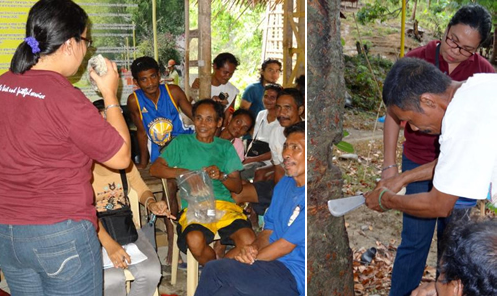
Description and Characteristics
The almaciga is a vast tree that grows up to 65 meters tall and the trunk up to 3 meters in diameter. It has green, leathery leaves that are opposite, broad, shaped like an oval (or sometimes with a narrower portion from middle to tip) that develop up to seven centimeters (7cm) long and two centimeters (2cm) wide. It produces cones that measure up to five cm (5cm) long for male cones which are usually cylindrical; while up to eight centimeters (8 cm long) for female cones commonly resembling the shape of a globe but not having the perfect shape of a sphere or ball. Its bark is gray and smooth, and oozes out white liquid material called “resin” whenever cut. This resin is what makes almaciga highly valued in the world.
Location and Sources
Almaciga commonly grows in primary forests at 200 to 2000 meters above sea level which is the geographic characteristics of most forests in northern Luzon and some parts of Mindanao. It has acquired various local names in different parts of the Philippines. Almaciga can be found in low-land forests of Quezon, Zambales, Palawan, Cagayan, Abra, Kalinga Apayao, Nueva Vizcaya, Samar, Zamboanga, and Davao. In some provinces like Palawan, almaciga trees have become a big source of income for locals and indigenous groups who have lived in the area since time immemorial.


Application and Product Output
The almaciga tree has gained its economic importance because of the resin that it produce ⎯ commonly known as “Manila copal” — which is used in all classes of building and general construction, tank and vat manufacture, military bridging, production of dairy and agricultural machinery, and for engineering pattern work. More specifically, the resin produced from cutting the bark of almaciga is used widely in manufacturing varnishes, lacquer, soap, paint, waterproofing materials, linoleum, paper sizing, and other products. Locals also use different parts of the tree for various applications ranging from medical to construction and decoration. Almaciga is used for torches and as starting fire, incense, fuel wood, caulking substance, and smudge for mosquitoes. In some places, resin is used as liniment and aid for arthritis while burning resin’s smoke is used for asthma. Furthermore, its powdered wood is used to treat headache and muscle pains. In some parts of Luzon, people drink a decoction of almaciga’s fresh leaves with stems for stomach ache, ulcers, and dysentery. The cones can also be dried for decoration purposes.

Production and Sustainable Consumption
Almaciga resin is an important export product of the Philippines, raking in 1,139,900 USD worth of export revenues from 2006 – 2015. For this economic value, over-harvesting and illegal logging now threaten its existence. Currently, almaciga logging is banned by the Philippine government and many non-government organizations have initiated projects to teach and impart knowledge on sustainable community-based almaciga propagation and resin tapping including “Saving the Almaciga” by Fins and Leaves. In this project with duration from 2015 to 2017, indigenous and local communities of Palawan propagated over 500 Almaciga seedlings in the first-ever Almaciga cone-based propagation nurseries in the Philippines, created management plan and scientific documentation for the species, and setup an enforcement team for saving almaciga.
On the other hand, the Philippine government thru the effort of DOST-FPRDI (Department of Science and Technology – Forest Products Research and Development Institute) has launched different initiatives to saving the country’s remaining almaciga trees by teaching tribal communities the correct way of resin tapping for more than 20 years now. In 2013, the institute launched the project “Enhancing the Adaptive Capacity of Indigenous Peoples by Promoting Sustainable and Community-Based Resin Tapping of Almaciga in selected Certificate of Ancestral Domain Title (CADT) Areas in Palawan and Sierra Madre” which taught 144 indigenous people (IP) beneficiaries the right way of resin harvesting, it also oriented them on the basics of climate change and impact on forest ecosystems, and how the communities can adapt to it.
Photo of Almaciga seedlings propagated by “Saving the Almaciga” project initiated by Fins and Leaves.

As part of the project “Saving the Almaciga Tree” by the Centre for Sustainability, a non-profit organization, a representative from DOST-FPRDI conducted lecture and hands-on exercise on the right way to harvest resin from the almaciga tree to a group of indigenous people in Puerto Princesa City, Palawan which was held last May 2016.

Through this hand-in-hand efforts of the public and private sectors with the cooperation of local communities, the government aims to replace and sustain the species that are reportedly dying due mainly to heartwood rotting and destructive resin harvesting. There are different projects, studies, and recommendations to ensure the future of the almaciga trees as they play an important role not just in the country’s economy but most especially in protecting our forests.
Supported by the Connections Through Culture programme of the British Council, our Materials Library Expansion Project is the first collaboration between UNESCO Creative Cities of Design #Cebu and #Dundee.#MATIC#CreativeDundee#BritishCouncilPh#BritishCouncilCTC“
Works Cited
“Almaciga”. BINHI: Let The Future Take Root, https://binhi.ph/tree/almaciga/. Accessed 15 January 2021.
“Almaciga”. Cainta Plant Nursery, https://caintaplantnursery.com/our-products/philippine-indigenous-plants/almaciga/. Accessed 15 January 2021.
“Saving the Almaciga Tree Project”. Fins And Leaves, http://www.finsandleaves.org/saving-the-almaciga-tree-project/. Accessed 15 January 2021.
Araral, Rizalina. “DOST-FPRDI helps save almaciga trees”. Department of Science and Technology – Forest Products Research and Development Institute, 11 Jan. 2017, https://fprdi.dost.gov.ph/239-dost-fprdi-helps-save-almaciga-trees. Accessed 15 January 2021.
Ella, Arsenio, Luis, Pilipinas , Samian, Florena. “IPs learn sustainable community-based almaciga resin tapping”. Southeast Asian Regional Center for Graduate Study and Research in Agriculture, 10 Sept. 2014, https://www.searca.org/news/ips-learn-sustainable-community-based-almaciga-resin-tapping/. Accessed 15 January 2021.
Stuart, Godofredo Jr. “Almaciga”. StuartXchange, http://www.stuartxchange.org/Almaciga. Accessed 15 January 2021.





